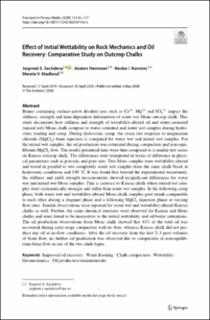| dc.contributor.author | Sachdeva, Jaspreet Singh | |
| dc.contributor.author | Nermoen, Anders | |
| dc.contributor.author | Korsnes, Reidar Inge | |
| dc.contributor.author | Madland, Merete Vadla | |
| dc.date.accessioned | 2023-01-05T08:30:45Z | |
| dc.date.available | 2023-01-05T08:30:45Z | |
| dc.date.created | 2020-05-07T11:12:20Z | |
| dc.date.issued | 2020 | |
| dc.identifier.citation | Sachdeva, J. S., Nermoen, A., Korsnes, R. I., & Madland, M. V. (2020). Effect of initial wettability on rock mechanics and oil recovery: Comparative study on outcrop chalks. Transport in Porous Media, 133(1), 85-117. | en_US |
| dc.identifier.issn | 0169-3913 | |
| dc.identifier.uri | https://hdl.handle.net/11250/3041098 | |
| dc.description.abstract | Brines containing surface-active divalent ions such as Ca2+, Mg2+ and SO42− impact the stiffness, strength and time-dependent deformation of water wet Mons outcrop chalk. This study documents how stiffness and strength of wettability-altered oil and water-saturated (mixed wet) Mons chalk compare to water-saturated and water wet samples during hydrostatic loading and creep. During hydrostatic creep, the strain rate response to magnesium chloride (MgCl2) brine injection is compared for water wet and mixed wet samples. For the mixed wet samples, the oil production was estimated during compaction and non-equilibrium MgCl2 flow. The results presented here were then compared to a similar test series on Kansas outcrop chalk. The differences were interpreted in terms of difference in physical parameters such as porosity and pore size. Two Mons samples were wettability-altered and tested in parallel to two completely water wet samples from the same chalk block at hydrostatic conditions and 130 °C. It was found that beyond the experimental uncertainty, the stiffness and yield strength measurements showed insignificant differences for water wet and mixed wet Mons samples. This is contrary to Kansas chalk where mixed wet samples were systematically stronger and stiffer than water wet samples. In the following creep phase, both water wet and wettability-altered Mons chalk samples gave trends comparable to each other during a stagnant phase and a following MgCl2 injection phase at varying flow rates. Similar observations were reported for water wet and wettability-altered Kansas chalks as well. Further, the same chemical reactions were observed for Kansas and Mons chalks and were found to be insensitive to the initial wettability and oil/water saturations. The oil production observations from Mons chalk showed that 43% of the total oil was recovered during early-stage compaction with no flow, whereas Kansas chalk did not produce any oil at no-flow conditions. After the oil recovery from the first 2–3 pore volumes of brine flow, no further oil production was observed due to compaction or non-equilibrium brine flow in any of the two chalk types. | en_US |
| dc.language.iso | eng | en_US |
| dc.rights | Navngivelse 4.0 Internasjonal | * |
| dc.rights.uri | http://creativecommons.org/licenses/by/4.0/deed.no | * |
| dc.title | Effect of Initial Wettability on Rock Mechanics and Oil Recovery: Comparative Study on Outcrop Chalks | en_US |
| dc.type | Peer reviewed | en_US |
| dc.type | Journal article | en_US |
| dc.description.version | publishedVersion | en_US |
| dc.rights.holder | the authors | en_US |
| dc.subject.nsi | VDP::Matematikk og Naturvitenskap: 400::Geofag: 450 | en_US |
| dc.source.pagenumber | 85-117 | en_US |
| dc.source.volume | 133 | en_US |
| dc.source.journal | Transport in Porous Media | en_US |
| dc.source.issue | 1 | en_US |
| dc.identifier.doi | 10.1007/s11242-020-01416-x | |
| dc.identifier.cristin | 1809755 | |
| dc.relation.project | Norges forskningsråd: 230303 | en_US |
| cristin.ispublished | true | |
| cristin.fulltext | original | |
| cristin.qualitycode | 2 | |

